SU-85 Tank Destroyer
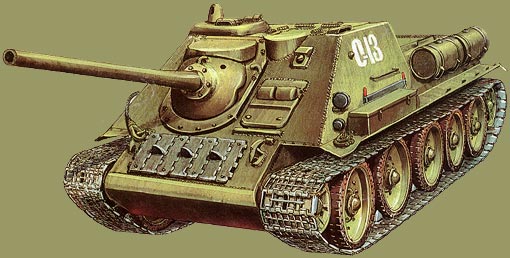 SU-85 tank destroyer of the 3rd Ukrainian Front. Rumania, August 1944.
SU-85 tank destroyer of the 3rd Ukrainian Front. Rumania, August 1944.
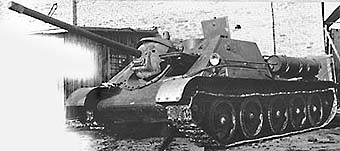
The SU-85-I. (M.Baryatinsky) |
When the first German "Tiger" was captured at Leningrad in January 1943, the Soviet High Command was shocked. Its armor was too thick for most Soviet guns. The most common Soviet tank gun, the F-34 (installed in the T-34-76) and the ZiS-5 (installed in the KV-1) could penetrate it only from suicidal distances.
Special ballistic tests showed that the M-30 howitzer (mounted on a SU-122 assault gun) wasn't effective against the Tiger. Using the HEAT ammunition, M-30 was able to penetrate the Tiger's armor, but slow rate of fire and curved trajectory (don't forget that M-30 was a howitzer, not a field gun) made SU-122 as a quite easy target.
A special tests revealed that the two most effective guns against the Tiger's armor were the 85 mm AA-gun and the 122 mm A-19 corps cannon. So, Petrov's design bureau was ordered to develop a new tank destroyer - an 85 mm gun that would be mounted on an SU-122 chassis which had been designed by L.Gorlitsky. |
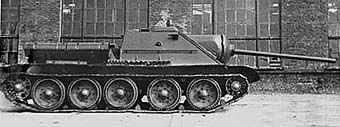
The SU-85-IV. (M.Svirin) |
That is why, by the GKO order from May 5, 1943, a F.F.Petrov's design bureau has started works on adapting the 85 mm AA gun model 1939 for further rearm with it SU-122. Simultaneously, the TsAKB (a design bureau lead by V.Grabin) has started their works on rearming SU-122 with already existed 85 mm S-18 gun. Initially, that has been developed for KV heavy tanks. A slightly improved, with new gun mantlet and new gun-cradle, S-18 was delivered to the Uralmash.
However the attempt to install it in the standard compartment of SU-122 was failed because of too big breech end of the gun. Uralmash tried to reject all further works cause it led to modernisation of a whole hull, thus it led to a big expenses. However it was forced to continue works. As a result, two different vehicles have been built.
The first one - the SU-85-I - had a standard hull of the SU-122, but had the new gun-cradle and the new gun mantlet. The initially proposed coaxial machine-gun was later removed because of lack of room.
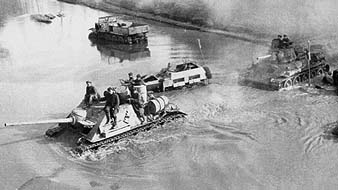
Armored column crossing the Dnestr river with an SU-85 tank destroyer in the lead. The river is littered with abandoned German equipment, including a Sd Kfz 250 APC and derelict 3-ton half-track. |
The second one - the SU-85-IV - was based on the SU-122 as well, but had a modified front. Both self-propelled guns were armed with the 85 mm Tank Gun S-18.
As I said above, simultaneously the works on S-18, works on installing the Petrov's 85 mm D-5S gun into to SU-122 have been conducted. Initially D-5S was considered as a temporal step until the problems with S-18 will be solved. However, on a comparative trials, D-5S showed the same ballistic but better performance and reliability. Nevertheless the successfully passed trials, the existed gun-cradle didn't allow to add a telescopic sight. Thus, a new sight TSh-15 has been developed. The new self-propelled gun was named SU-85-II.
Comparative trials proved the superiority of the SU-85-II over the SU-85-I. The SU-85-IV was removed from trials earlier because of some serious defects. SU-85-II was accepted for service as a "self-propelled antitank gun SU-85".
The SU-85 had 48 rounds for its gun, in addition it had 1500 rounds for the crew's sub-machine guns, 24 grenades F-1 ("pineapple") and 5 antitank grenades. The transmission, engine and most of other components were left unchanged (the same as in the T-34-76), allowing easy transition for new crews. |

The destroyed SU-85 investigated by German soldiers. Central Poland, summer 1944. |
The first batch TD's were equipped with an armored commander's cap. Later it was replaced by the standard commander's cupola - the same as on the T-34/76 model 1943. Besides, crew could use a prismatic observation sights installed in left side and rear. On later vehicles the some additional optic was installed which made an almost all-round observation.
In the front and the sides there were embrasures for firing with small firearms. These embrasures might be closed with a conic spigots. Basically, SU-85 was similar to SU-122 excluding its armament. |

The SU-85 from the Polish 13th Regiment of Assault Guns in late April 1945. |
In September 1943, during the Dnieper crossing, there was the very first usage of SU-85's. This TD become a very popular in the Red Army due to its powerful gun that was able to penetrate German Tigers and Panthers from a quite long distances. For example, in 1944, during the summer offensive, the 1021st Self-Propelled Artillery Regiment (1st Baltic Front) destroyed over 100 German tanks. Another example, taken from a commander's report of the 1st Guards Tank Army):
"During all phases of the battle, the new tank destroyers played a key role in supporting our armored attack. New TD's were very effective against enemy tanks. They had of good armor protection and their guns could kill targets at great distances. In addition, new TD's proved to be very effective in defensive." |

A SU-85 from Polish 13th Regiment of Assault Guns in Germany in 1945. The slogan on the wall says "Polish soldiers advance on Berlin". |
With the advent of the deadlier SU-100 Tank Destroyer, the production of SU-85's was canceled. Sum totally, 2329 SU-85's and 315 SU-85M's were built.
The SU-85 saw service beyond the Red Army: 70 SU-85's served in the Polish Army (Voisko Polskoye) and 2 vehicles served in the Czech Corps.
Because of problems with with 100 mm AP ammunition, the mass production of the SU-100 was delayed. At the same time, the SU-85 was already removed from production (from July 1944). |
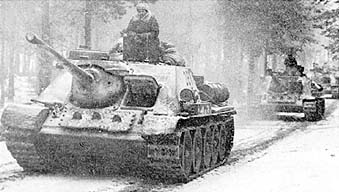
A column of SU-85M tank destroyers marching through snow-capped forest in Eastern Prussia. January 1945. |
Thus, a temporal step was made: a SU-100 tank destroyer armed with an 85 mm D-5S was developed and set up in the mass production. That "temporal" variant received SU-85M designation. It distinguished from common SU-85 by thicker frontal armor (75 mm instead of 45 mm) and by spacious compartment. It produced until December 1944, when the production of SU-100 was launched.
Besides of the production SU-85s and theSU-85Ms, there were several experimental vehicles which didn't accept by various reasons. |

The SU-85BM. (M.Svirin) |
In autumn 1943, after the long and detailed investigating of the German heavy tank destroyers "Ferdinand", GAU ordered some design bureaus to develop a new more powerful antitank gun which would be able to fight with German heavy tanks and TDs. As an example it was suggested to use German 8.8cm PaK 43.
One of the first project was offered by F.F.Petrov's design bureau. A redesigned D-5 gun - which was designated D-5S-85BM - had longer barrel. Using a standard 85 mm rounds and increased powder propellant charge, the muzzle brake of AP round was increased up to 950 m/s. At the same time, new gun allowed to use a standard ammunition as well. Gun was installed in the hull of the standard SU-85. New TD was named SU-85BM ("BM" means "bol'shaya mosh'nost" - of special power). From January to March 1944 it was tested on a proving ground. By its results, SU-85BM was not accepted for service. |
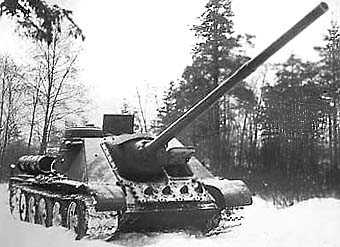
The SU-D-10-85. (M.Svirin) |
Notwithstanding the previous attempt, in autumn 1944 Petrov's design bureau offered another variant of 85 mm gun: a 100 mm B-34 which was re-bored to the 85 mm caliber. New gun was named D-10-85PM and tank destroyer - SU-D-10-85. It used a standard 85 mm rounds and 100 mm cartridges. In summer 1944, the new TD was tested but didn't accepted for service. |

The SU-S-34-1. (M.Svirin) |
Besides of Petrov's design bureau, the Grabin's design bureau was involved. In spring 1944, it developed a new tank destroyer SU-S-34-1 armed with 85 mm S-34-IB gun. It had an unusual ammunition: a 85 mm round with a 100 mm cartridge. In summer 1944, the new TD was tested but didn't accepted for service. |
Personalmente creo que desde su entrada en combate y hasta su sustitución
Fue el mejor caza tanques de su tiempo, por velocidad, sencillez de manejo, armamento y coraza, que le permitieron enfrentarse a los carros pesados alemanes con bastante éxito, conjuntamente y en apoyo de los inigualables T-34 J! Reactions Commenting Software
General Site License
Copyright © 2006 S. A. DeCaro |


















